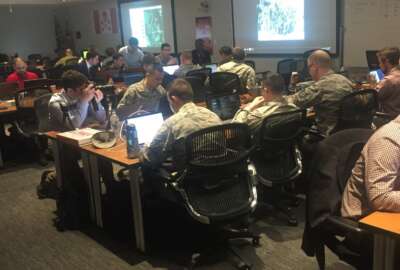NSA gives military students a leg up on cyber with real-time exercise
The National Security Agency is holding its 17th annual Cyber Defensive Exercise to help young cyber warriors hone their skills.
The National Security Agency is amping up its game when it comes to challenging young, college-age students in military academies on their cyber skills.
The agency is hosting its 17th annual Cyber Defense Exercise (CDX), but with a few new twists.
The exercise challenges students at the U.S. Military, Naval, Coast Guard and Merchant Marine academies, as well as undergraduate and graduate students from the Royal Military College of Canada.
Their mission is to defend networks they have created from a red team comprised of U.S., Canadian and industry cyber warriors.
Along with defending the network, the teams have certain challenges they need to secure as well.
“What this does is challenges them to look into forensics and see where malware lies and where things happen,” said James Titcomb technical lead for CDX said April 12.
The challenges consist of reverse engineering and malware analysis, network forensics, offensive ethical hacking and control of a simulated drone.
The graduate students are testing two new challenges that involve securing a space satellite and an unmanned ground vehicle.
“This year what’s new is we have two cadets from the Air Force academy” participating in the red team, said Shirley McMonigle, CDX program lead. This is also the first year the undergraduates will participate in the drone challenge.
This year teams will have to deal with ransomeware as well. The teams can either pay points to get out of the hack or try to fix it.
Teams are scored on network confidentiality, usability, integrity and on the challenges.
NSA uses a red team to interfere with students’ networks and their ability to complete the challenges. Much of the intrusions find their way into the students’ networks through a gray team, which acts as a network user.
The gray team may fall for social engineering tactics.
“Most of our access is done through the gray cell. We call it the user that clicks on everything. … What we do is we purposely throw things and have the gray cell open those links so that we can own their work stations. [The teams] have to go in and mitigate that,” Titcomb said.
The red teams are a way for those in the military to keep their skills sharp too.
Air Reservist Lt. Tim Li said he works in cybersecurity for J.P. Morgan. He said acting as a hacker helps him understand the other side of the cybersecurity coin.
“It’s fun, it’s the opposite for me of what I do on the outside. … It’s learning what the attacker would do, so it will definitely be beneficial for me once I return to my civilian job,” Li said.
The students embedded this year with the red team said they were taking in a lot from the experience.
Nick Co, a 22-year-old midshipman, said he could see himself working for U.S. Cyber Command or the NSA at some point in the future.
That’s good news for the military, which is strapped for people with cyber talent in the service.
“I think for us some of it is trying to understand the basics first. We are still hugely learning, but we know that the field is really growing and we definitely know they could use some officers out there,” Co said. “These guys are the real professionals so it’s fun to really learn from them and take this back and hopefully when we graduate implement this.”
Copyright © 2025 Federal News Network. All rights reserved. This website is not intended for users located within the European Economic Area.
Scott Maucione is a defense reporter for Federal News Network and reports on human capital, workforce and the Defense Department at-large.
Follow @smaucioneWFED




